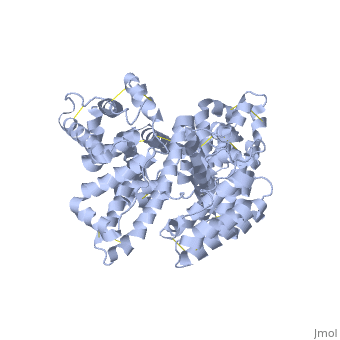Mahalia Serrano/Sandbox1
From Proteopedia
HUMAN SERUM ALBUMIN (HSA)
|
Human serum albumin (HSA) is the most abundant protein in the blood plasma, amounting to about 35 to 50 grams per liter of serum. With a molecular weight of about 66.5 kDa, it functions mainly to maintain the pH and osmotic pressure of the blood and to transport a wide variety of endogenous and exogenous substances.
Structure
HSA exists as a monomer that is comprised mostly of alpha helices. Each of the (domain I, domain II, domain III) are further divided into subdomains A and B (A=darker shade, B=lighter shade), which form several hydrophobic pockets throughout the molecule.
Function
Being the major protein in blood, it functions to maintain the osmotic pressure and the pH of the blood. But most importantly, it functions to transport various substances through the bloodstream. HSA does not carry a specific cargo, although it does have preference for fat-soluble substances as it can bury the water-insoluble molecules into its hydrophobic core. Here, we can see to its hydrophobic pockets. HSA transports a wide variety of substances through the bloodstream including carbohydrates (e.g ), fatty acids (e.g. ), hormones (e.g. , a thyroid hormone), and drugs (e.g. , an anti-inflammatory drug).
Because HSA is very abundant in blood serum, most biomarker studies involving serum requires preliminary removal of HSA so that other non-abundant but otherwise important disease-indicating proteins can be detected. In our group, we exploit several properties of HSA in order to efficiently remove it from serum prior to biomarker analysis. These properties include its low isoelectric point (pI of about 4.7) due to a number of , and its tendency to bind hydrophobic molecules through its hydrophobic pockets.

